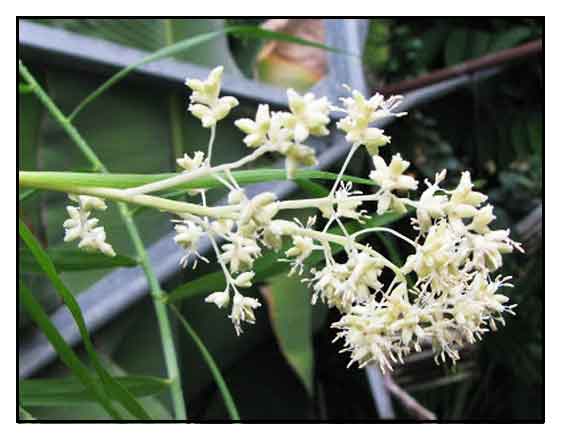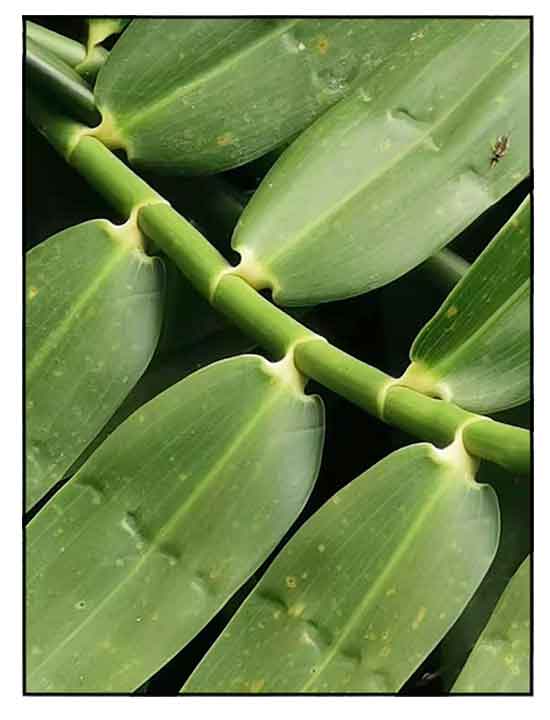|
 Gen info Gen info
- Flagellaria is the sole genus in the family Flagellariaceae. It consists of only five species: Flagellaria collaris, F. gigantea, F. guineensis, F. indica, and F. neocaledonica. (20)
- Flagellaaria indica is a climbing plant found in many of the tropical and subtropical regions of the Old World, India, Bangladesh, Southeast Asia, Polynesia, and Australia.
(21)
- Etymology: The genus name Flagellaria derives from Latin flagellum, meaning 'tendrilled', referring to the leaf tips ending in coiled tendrils. The species name indica derives from Latin, referring to India or one of the localities in the East Indies of its natural distribution. (25)
Botany
• Baling-uai is a reedlike
plant, climbing night on trees through the leaf tendrils. Stem
is about 2.5 centimeters thick towards the base, terete and smooth. Leaves
are sessile, 15 to 25 centimeters long, variable in breadth, 2 to 4 centimeters or more, lanceolate from a rounded
base and terminating in a curled tendril at the apex. Flowers are
white, borne in clusters, shortly pedunculated, with irregular laxly branched
panicles, 15 to 30 centimeters long. Outer perianth-segments are broadly ovate or suborbicular, and the inner segments similar, more or less unequal. Fruits are rounded and smooth, red when
mature, about 5 millimeters in diameter.
 • A strong climber, it grows often up to 15 metres (49 ft) tall, with thick cane-like stems exceeding 15 millimetres (19⁄32 in) in diameter. Its leaves, without hairs, are 10 to 40 centimeters (4 to 16 in) long, and 5 to 20 millimetres (3⁄16 to 25⁄32 in) wide. A coiled apex of the leaf forms the holding part of the climbing plant. Fragrant white flowers form in panicles, 10 to 25 centimeters (4 to 10 in) long. The fruit is inedible. Globose drupes are red when mature, 5 millimetres (25⁄128 in) in diameter, usually with only one seed. (21) • A strong climber, it grows often up to 15 metres (49 ft) tall, with thick cane-like stems exceeding 15 millimetres (19⁄32 in) in diameter. Its leaves, without hairs, are 10 to 40 centimeters (4 to 16 in) long, and 5 to 20 millimetres (3⁄16 to 25⁄32 in) wide. A coiled apex of the leaf forms the holding part of the climbing plant. Fragrant white flowers form in panicles, 10 to 25 centimeters (4 to 10 in) long. The fruit is inedible. Globose drupes are red when mature, 5 millimetres (25⁄128 in) in diameter, usually with only one seed. (21)
• Compared to other climbers, F. indica possess unique adaptations to the climbing habit. Flagellaria indica has evolved a rapid growth and tendril-like leaf species. The tendril-like leaf tips pass several stages during attachment. Anatomical and biomechanical adaptations ensure the connection between leaf and host. The strong attachment of the leaf tips are strengthened by lignified tissue. The strong connections allow F. indica to grow into the forest canopies. (26)
Distribution
- Native to the Philippines.
-
From Batanes Islands to Mindanao and Palawan, in all or most islands and provinces, in secondary forests at low and medium altitudes.
- Also native to Andaman Is., Assam, Bangladesh, Bismarck Archipelago, Borneo, Cambodia, Caroline Is., China Southeast, Comoros, Fiji, Hainan, India, Japan, Jawa, Lesser Sunda Is., Madagascar, Malaya, Maldives, Maluku, Marianas, Mauritius, Mozambique, Myanmar, Nansei-shoto, New Caledonia, New Guinea, New South Wales, Nicobar Is., Norfolk Is., Northern Territory, Queensland, Rodrigues, Réunion, Santa Cruz Is., Seychelles, Solomon Is., Sri Lanka, Sulawesi, Sumatera, Taiwan, Tanzania, Thailand, Vanuatu, Vietnam, Wallis-Futuna Is., Western Australia. (9)
 Constituents Constituents
- Study of various extracts of leaves for phenolic content in gallic acid equivalents yielded 153.28 mg/g for ethyl acetate extract, 134.78 mg/g butanol, 65.88 mg/g aqueous, 55.28 mg/g chloroform, 45.98 mg/g methanol and 22.78 mg/g hexane. Total flavonoids in catechin equivalents were highest in the ethyl acetate extract (38.9 mg/g), followed by butanol (28.45 mg/g), aqueous (21.18 mg/g), chloroform (12.9 mg/g), methanol (10.78 mg/g) and hexane (4.92 mg/g). (see study below) (14)
- Phytochemical screening of aerial parts yielded the presence of alkaloids, flavonoids, saponins, tannins, terpenoids, and reducing sugars. (see study below) (24)
Properties
- Stems and rhizomes are diuretic.
- Leaves are astringent and vulnerary.
- Studies have suggested anti-Dengue virus, antioxidant, hepatoprotective, anthelmintic, coagulant, laxative, diuretic, analgesic, antidiabetic, cytotoxic properties.
Parts
used
Stem, rhizome, leaves.
 Uses Uses
Edibility
- Young leafy shoots cooked and eaten as vegetable. Stems yield a sweet sap and chewed like sugar cane. (12)
- In Madagascar, leaves and stems used for making tea.
(12)
- Some compilations report the fruit as edible; some as inedible.
Folkloric
- Decoction of stems and
rhizome used as diuretic.
- Leaves are astringent and vulnerary.
- Plaster of leaves used on wounds.
- Tips of leaves applied to sore eyes.
- Young leaves used for making hair wash and to promote hair growth.
- Decoction of flowers and leaves used as diuretic.
- Plant used as contraceptive; stem used to induce sterility.
- Used for postpartum baths. (See: Suob)
- Reported use of leaves for contraception.
-In Malaysia, boiled root
is taken three times daily as health tonic. The Murut tribe in Sabah boil the whole plant and use the water as a bath for semi-paralytic conditions.
- In Malaysian Borneo, decoction of roots taken for influenza, cough and vomiting.
- In Vanuatu, to induce infertility, a handful of leaf buds are crushed with water and salt; to drink a glass of the juice before breakfast, to continue for the following four days. Leaves of whole plant used as contraceptive. (3)
- In Papua New Guinea, infusion of chopped pieces of fresh stalk drunk to relieve stomachache, diarrhea, and dysentery. Fresh young leaves are boiled, cooled, and drunk to treat asthma, shortness of breath and fever. (13) Roots used as contraceptive. (16)
- In West Papua, the indigenous people of Manokwari use stem juices for fever. (15)
- In Australia, reported aboriginal use of sap from vine to relieve sore eyes. (17)
- In India, leaf used as contraceptive. (19)
Others
• Rituals and superstitions: The "huwag" vine from Flagellaria indica is used in
the mananambal's Lenten rituals of producing curative concoctions and
brews for sorcery.
• Weaving: In Australia, report of aboriginal use of stem strips for binding baskets and and sewing together sections of canoe hulls. (18) Used for basketry, but of inferior quality to rattan. Also used in making fish traps, nets and rope.
• Hair wash: Leaves used for hair washes.
Studies
• Anti-Dengue Activity: Study evaluated Thai medicinal plants for in-vitro anti-dengue activity. In an antiviral assay, Flagellaria indica showed 45.52% inhibition of DENV-2 in vitro at 12.5 µg/mL of ethanol extract. The CC50 of the ethanol extract was 312 gm/L. Results showed significant potential effect and suggested a potential for the development of anti-DENV drug. (8) (11) In vitro study of whole plant showed inhibition 45.52% inhibition of DENV-2 at a dose of 12.5 µg/mL. (23)
• Hepatoprotective / CCL4-Induced Toxicity / Antioxidant / Leaves: Study evaluated the hepatoprotective mechanism of F. indica against carbon tetrachloride (CCl-4)-mediated liver damage in adult Sprague-Dawley rats. Total phenolic content in the aqueous extract of leaves was 65.88 ± 1.84 mg gallic acid equivalent/g. IC50 value for free radical scavenging was reached at extract concentration of 400 µg/mL. Immunochemical results showed the suppression of oxidative stress markers and pro-inflammatory markers (TNF-α, interleukin-6, prostanglandin E2). Findings suggest the presence of phenolic contents and their antioxidant effects can be credited to the hepatoprotective activity. (10)
• Antioxidant / Leaves: Study evaluated the antioxidant capacities of leaves of Flagellaria indica and phytochemical constituents of six different extracts. On DPPH assay, the highest values for radical scavenging were in the order of butanol>ethyl acetate>chloroform>methanol>hexane. Total phenolic content was also highest in the EA extract (38.96 mg/g) using catechin equivalents. Antioxidant and radical scavenging activity may be due strong presence of phenolic constituents, flavonoids and several bioactive compounds. (14)
• Anthelmintic / Coagulant / Diuretic / Laxative / Leaves: Study evaluated crude ethanolic extract and fractions of leaves for biologic activities. In anthelmintic testing, the n-hexane fraction showed moderate effect with paralysis times of 16.79 and 13.62 minutes and death times of 27.34 and 21.81 minutes, respectively, at doses of 25 and 50 mg/mL. In blood coagulation test, only the water fraction showed notable effect. with clotting times of 4.33, 6.02, 7.68, and 8.32 minutes, respectively, at doses of 200, 100, 50, and 25 mg/mL. Measuring urine volume excretion, electrolytes, pH, natriuretic, kaliuretic, saluretic and CAI indexes, the ethyl acetate fraction showed better diuretic effect than the n-hexane fraction, while the water fraction showed no notable effect. The n-hexane fraction showed best laxative effect, with increase in stool weight of 38% and 54% at doses of 250 and 500 mg/;kg, respectively. (22)
• Antidiabetic / Antidiarrheal / Analgesic / Cytotoxic / Aerial Parts: Phytochemical screening of aerial parts yielded the presence of alkaloids, flavonoids, saponins, tannins, terpenoids, and reducing sugars.
Extract showed significant (p<0.01) anti-diarrheal activity against casto9r oil-induced diarrhea in mice, with decreased frequency of defecation and increased mean latent period at doses of 250 and 500 m/kbw compared to loperamide at 3 mg/kbw. In acetic acid-induced writhing, the ethanol extract (250 and 500 mg/kbw) showed significant (p<0.01) inhibition of writhing reflex (43.55% and 60.9%, respectively), compared to diclofenac sodium (73.8%). On oral glucose tolerance test (OGTT), there was dose-dependent reduction of blood sugar in glucose loaded mice at 250 and 500 mg/kbw compared to glibenclamide. In brine shrimp lethality testing, the extract showed cytotoxicity with LC50 of 71.89 µg/mL compared to standard drug vincristine with LC50 of 0.39 µg/mL. Results tend to justify the traditional uses of the plant. (24)
Availability
Wild-crafted. |



![]()

